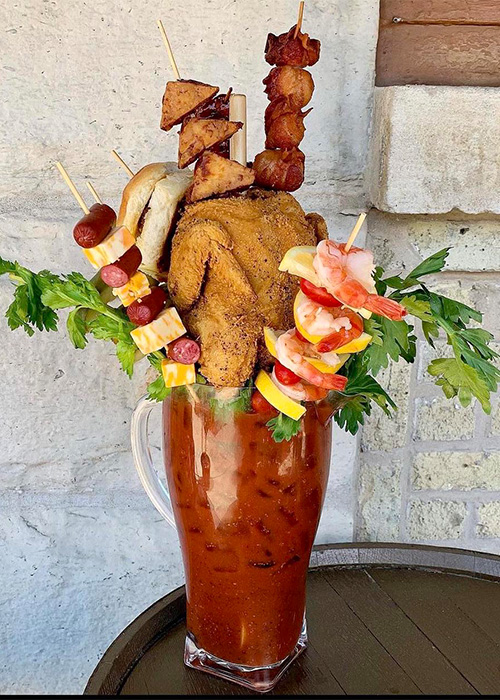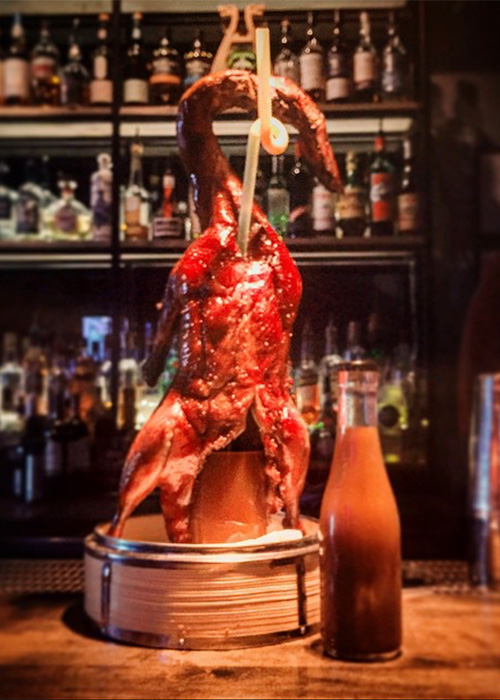The Bloody Beast, a $60 Bloody Mary garnished with a whole fried chicken at Sobelman’s Pub & Grille, began life in 2014 as a joke, like almost all of the Milwaukee pub’s over-the-top Bloodies. A server brought in an 80-ounce Mason jar she’d found at Bed, Bath & Beyond, effectively challenging bar owner and founder Dave Sobelman to build a Bloody befitting of its gargantuan size.
It didn’t suffice to adorn it with skewers of bacon-wrapped jalapeno cheese balls, pickled vegetables and sausages, poached shrimp, grape tomatoes, celery stalks, and scallions. This spicy Bloody called for something wackier: How about a three-and-a-half-pound chicken battered in Wisconsin beer and flour, deep fried, and run through with a fryer hook? Never mind that the bar sells 20 to 30 Bloody Beasts each weekend (and up to a third of its business comes from Bloody Marys); Sobelman still can’t believe this is all real.
“Every time that thing leaves the bar, I still shake my head like, ‘This is crazy,’” he says. “But when a waitress takes one to a table, conversations stop. People jump up to take a picture, they’re all talking about it. It just goes to show you can’t go too far when it comes to Bloody Mary garnishes.”
Don’t Miss A Drop
Get the latest in beer, wine, and cocktail culture sent straight to your inbox.
Then again, this comes from the unhinged mind that claims to have ushered in the era of outrageous Bloody garnishes in 2012, when he stuck a cheeseburger slider in a Bloody Mary and posted it on Facebook with the caption, “Am I going too far?” Sobelman’s viral stunt set off an unspoken Bloody garnish war across Brew City.

Such madness isn’t unique to Milwaukee, despite its well-earned reputation as a hard-drinking town — which Sobelman deems the reason outrageous Bloodies play so well there. If you order a Crabby Mary at Stingray’s Restaurant in New Orleans, said cocktail stares back with two olive eyes protruding from a fried soft shell crab “head,” complete with smiling lemon wedge mouth, green bean antennae, and fried shrimp and hush puppies. The Zeus Bloody Mary at the Blind Pelican Seafood House in Holly Springs, N.C., arrives adorned with skewers of lobster, crab legs, grilled cheese, bacon, and a 6-ounce filet mignon — oh, and a side of raw oysters. At CC’s Kitchen in Louisville, the Beast sports a garnish of whole smoked and fried chicken, two corn dogs, a footlong sausage, and an ice cream cone full of housemade cotton candy, “which you might want for dessert,” owner Corey Milliman says.
Friends like sharing such concoctions with Sobelman when they come across them, by the way. Call it Bloody baiting.
Hungover, frivolous beginnings
How did a mildly absurd brunch cocktail achieve such levels of silliness that burgers, BBQ ribs, and whole fowl adorn its rim? It would be tempting to name social media as the main culprit, but the Bloody Mary has flirted with meal-crossover status since its oft-disputed origins in the 1920s or ‘30s. Moreover, it has always elicited playful disdain from certain drinking elites — something its architects have leaned into over time.
“Since the early days of the Bloody Mary, there were joking references to the idea that the olive or food-like thing they were garnishing with was a life-saving bit of sustenance the morning after,” says author and drinks historian Christine Sismondo, who co-wrote the 2022 book “Cocktails: A Still Life.” “There was almost a natural progression toward adding more things.”
Yet the Bloody Mary’s freak seeds were sowed long before its garnishes went off the rails. “Silly drinks” like this crop up occasionally in our drinking history, Sismondo says, often as a reaction to self-serious cocktail culture. Indeed, why not counter the purist Prohibition-era cocktail — impeccably balanced and bearing only functional garnishes — with a striped, sickly sweet Pousse Café? She directs me to Jack Townsend and Tom Moore McBride’s 1951 book, “The Bartender’s Book,” and a chapter therein titled “Freak Drinks,” where the authors cheekily lament the “exhibitionists” and “crooks” who order these nonsensical cocktails.
“There’s something about the expansive flourish they bring to the bar that tells [the bartender] what they are and what they’ll order,” Townsend and McBride write. “It’s as if they wore those tie clasps that light up with neon … the way this phony aura radiates from them. These are the men and women who order drinks like Zombies and Pousse Cafés, drinks that have no reason for being that the bartenders hate with a purple passion.”
And lo, listed among the Moscow Mule and Prairie Oyster is a Bloody Mary (ungarnished, mind you) — a hair of the dog and “savage mixture of tomato and vodka.” Even as the prose drips with scorn, it winks at us, too, as if to say we’re all a little freaky deep down. (After all, these cocktails made it into the book.)
“Something happens cyclically with cocktails,” Sismondo says. “There’s this kind of frivolity people are looking for — the ‘I don’t care about integrity, I want something fun and entertaining that we can talk about at the bar.’”
Before social, there was the drinks tray
Fancy garnishes date back to the 19th century, when bartenders were known to set orange peels aflame and heap cobblers and juleps with fresh fruit. All were food-based and largely practical, and we instead have the post-Prohibition tiki wave to thank for the rise of non-edible, theatrical embellishments like paper umbrellas and sprouting flowers.
Bloody garnishes likewise grew meatier into the late 1990s, when it wasn’t uncommon to see the drinks crowned with celery stalks, poached shrimp, and all manner of pickled vegetables. In 1997, The New York Times reported that bars like Elroy’s in San Francisco and the Rainbow Room’s Promenade Bar in Manhattan added build-your-own Bloody Mary stations “with all the fixings,” owing to the immense popularity of the drink at the time. (A 1996 survey by trade publication Market Watch cited in the story found that the Bloody Mary ranked third in popularity only to Margaritas and Vodka Sodas.)

After opening in 1999, Sobelman slowly amassed pickled goodies from neighboring manufacturer Bay View Packing, until a standard Sobelman’s Bloody garnish comprised 13 items, including a pickled brussels sprout, pickled asparagus spear, pickled sausage, and pickled mushroom. Back then, he drummed up interest the old fashioned way: building a Bloody, then parading it through the bar, pretending to look for the table that ordered it. Sure enough, heads turned and sales increased. But it wasn’t until that fateful, viral Facebook post that Sobelman’s Bloody Mary catapulted into the national conversation, and all but assured you’ll find at least a grilled cheese, bouquet of mozzarella “whips,” or brat slider adorning your Bloody wherever you’re brunching in Milwaukee.
“Any place that opens up, it’s just the expectation,” Sobelman says. “If you’re not going to make your Bloody Mary a little over the top, you’re going to be laughed out of Milwaukee.”
The ‘mic-drop’ Bloody garnish?
This playful one upmanship aligns with the rise of cocktail competition culture, which has also contributed to more emphasis on building and garnishing visually appealing drinks. Sismondo recalls judging a Bloody Caesar (a.k.a. Bloody Mary with Clamato) competition in Canada in 2015, in which winning bartender Simon Hooper seasoned his blended, bottled Caesar with hoisin, ginger, MSG, sriracha, and Canadian soil distillate. He garnished it with a glistening whole Peking duck by impolitely inserting said bottled cocktail and a silly straw into its cavity. “And you just drank it through the top of the duck,” Sismondo says. Naturally.
“The premise was that instead of putting an over-the-top garnish on the cocktail, I would put a ridiculous one around it,” Hooper adds, of his Spirit of Canada Caesar. “My ultimate goal was to be the ‘mic-drop’ of over-the-top cocktails, and I think I achieved this.”
With Instagram, bar owners have found that artistic and, by extension, outlandish garnishes — much like color-changing drinks — can prove reason enough to bring in customers from all over the place. “It’s driving the construction of drinks, for better or worse,” Sismondo notes.
Indeed, half of Sobelman’s weekend business — largely for its Bloodies — comes from out of towners. Similarly, CC’s Kitchen will see a noticeable uptick in orders when one of the city’s active foodie Facebook groups posts or reshares a photo of its garish Bloody Marys. Milliman admits he’s been neglecting Instagram, but that hasn’t stopped this two-year-old restaurant from routinely gracing local and national magazines’ top Bloody Mary lists. On a typical day, CC’s goes through 25 gallons of its house Bloody mix, which translates to some 240 16-ounce cocktails (its standard size). A surprising number of Beast orders come after dark: “People get it for dinner because there’s a lot of food in there — easily enough for two,” Milliman says.
Thanks to the Beast’s popularity, Milliman has since debuted a Mimosa version, which is built atop a pineapple (and has sprung a few copycats as far as Indiana). He’s also working on a Margarita version.
Give the exhibitionists what we want, right?


